
Annual speech gives new governors opportunity to fire up state residents
3/18/2007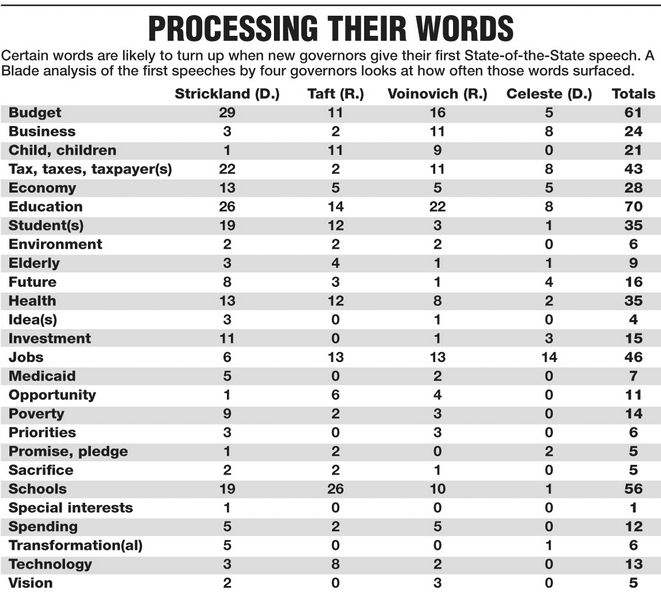
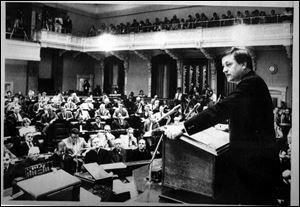
Democrat Richard Celeste took potshots at his predecessor, James Rhodes, saying the Republican left the state s coffers and economy in disarray.
Ohio governors mimic Major League baseball managers in one respect this time of year: giving people hope that better days are on the horizon.
Governors do that through their annual State-of-the-State address, which is usually thought of as a state version of the president s State-of-the-Union address.
But governors unlike presidents don t get nearly as much TV exposure, said state Rep. Bill Batchelder, a Medina, Ohio, Republican now back in the Ohio House for the first time since 1998 after more than three decades of service in that legislative chamber.
He said State-of-the-State addresses are one of the few times governors have the public s attention long enough to start a fire in people.
Perhaps that s why newly elected Ohio governors, at least ones in recent decades, have opted to deliver their State of the State in March instead of the bone-chilling cold of January, when the State of the Union is delivered.
Hope springs eternal in March. Governors don t dwell on the long, metaphorical doldrums of winter, just like baseball managers don t dwell on the previous season s losing records and missed title opportunities while getting their players in shape during spring training.
Mr. Batchelder likes that analogy. The irony, he added, is that even legislators tipped off about what will be said still get goose bumps when the State of the State is delivered.
Having it at this particular time is ideal because springtime is a time of hope and there s more daylight, said Curt Steiner, who wrote then-Gov. George Voinovich s first State of the State in 1991. Mr. Steiner went on to become Mr. Voinovich s chief of staff and is now Ohio State University s vice president for uni-versity relations. After two terms as governor, Mr. Voinovich went on to become one of the state s two U.S. senators.
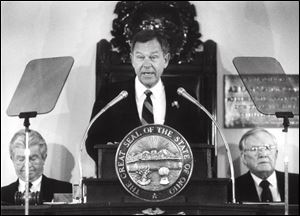
The buzzword phrase Republican George Voinovich used was new realities that is, the challenges posed by a sour economy in the Buckeye State.
A new ballgame
The first speech by a new governor especially one replacing a governor from an opposite party is a very special speech, Mr. Steiner said. It is the best opportunity for a new governor to fundamentally announce that it s a new ballgame.
By many accounts, Gov. Ted Strickland did just that and more with his first State of the State on Wednesday.
While some Republicans viewed his list of ideas as impractical or too expensive, others were impressed by the style, delivery, and substance of his remarks.
Or at least some combination thereof.
Strickland used it as an opportunity to present a bundle of new ideas and proposals. There s a lot of energy surrounding the Statehouse right now because of that, Mr. Steiner said. Everyone I have spoken with agrees it was a very well-done address. He looked comfortable.
Mr. Batchelder said Mr. Strickland came through big. The pressure was heightened because of former Gov. Bob Taft s scandal-ridden administration. Both parties were ready for a new governor, he said.
Governor Strickland certainly accomplished [the fact] that it s a brand new ballgame, Mr. Steiner said. He did it very artfully without any personal criticisms of anyone. That s not an easy trick.
Differing approaches
Democrat Richard Celeste did the opposite in his first State-of-the-State address on March 15, 1983.
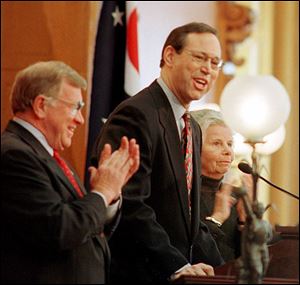
Republican Bob Taft encouraged innovative thinking in terms of work force training and development.
He took repeated potshots at his predecessor, Republican James Rhodes. Mr. Celeste accused him of leaving state government $528 million in debt and the state economy in such a mess that he pit one Ohio community against another in bidding for a Volkswagen plant. He also accused Mr. Rhodes of go-it-alone isolationism.
A recurrent theme, whether times are good or bad, has been a call to think outside the box.
Mr. Celeste said in his speech that he felt he had received a mandate from voters to tackle the [1983] recession with all the energy and imagination in our power.
Mr. Taft encouraged innovative thinking by calling upon state government to re-create the way it approaches work force training and development as Ohio s 21st Century economy becomes more high-tech.
Likewise, Mr. Strickland, while saying that we must live within our means, called on Ohio to retool its school system and think beyond neighboring states. We must set high standards to prepare our young people to compete with the world, to win in the global economy, he said.
Education and job training are obviously priorities in Ohio.
Those two subjects dominated the second half of Mr. Strickland s speech, while accounting for two-thirds of the speech Mr. Taft, a Republican, delivered on March 9, 1999.
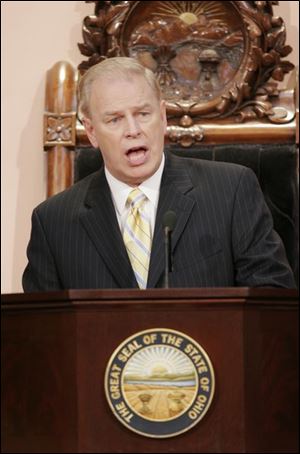
While saying that we must live within our means, Gov. Ted Strickland on Wednesday called on Ohio to retool its school system and think beyond neighboring states. We must set high standards to prepare our young people to compete with the world, to win in the global economy, the governor said.
Timing and buzzwords
Mr. Taft s address was made 10 days after a Perry County judge had ruled that the state s formula for funding schools was unconstitutional because of inequities between affluent and low-income districts.
He delivered his State of the State at a time when Ohio was anticipating the rare luxury of a $400 million surplus, prompting him to pepper his speech with the word opportunity.
Mr. Taft called for a historic level of financial resources to education, as well as expanded training opportunities.
He said he envisioned opportunity for every child to get a good education in a safe, secure classroom; opportunity for Ohioans to obtain good jobs at good wages; opportunity to keep more of their hard-earned money, and opportunity to improve the quality of their daily lives.
The buzzword phrase Mr. Voinovich used in both his inaugural address and his first State of the State was new realities that is, the challenges posed by a sour economy.
It is safe to say that we have never before found ourselves in the midst of a financial crisis of the magnitude we face today, he said in his 1991 State of the State.
He said Ohioans had to realize they lived in a state that was not working up to its capacity.
My vision for Ohio is a state whose leaders are as good and decent and honest as its people; a leader in education; a leader in fighting the war against crime and drugs, in providing access to quality, affordable health care; a leader in cleaning up our environment, and in providing a decent quality of life for all of our citizens, including those who cannot provide for themselves, Mr. Voinovich said.

Optimism and realities
Mr. Voinovich said he intended to do all that while closing what was then projected as a $500 million gap between Ohio s revenues and spending, even after $127 million in cuts had been made and a $400 million carryover had been spent.
Mr. Voinovich euphemistically had this to say about the task in front of him: As an old gardener, I have found over the years that sometimes it takes a little pruning to have a healthy plant.
Mr. Strickland beat the budgetary drum in his speech too.
While calling for more job training and other programs, he promised a modest 2.2 percent annual growth rate in state government that will be lower than in any budget in the last 42 years.
Mr. Strickland also tapped into the Republican mantra about government largesse by announcing Advantage Ohio, a program to eliminate contradictory and obsolete rules for business.
Mr. Voinovich veered off the norm in his speech, trying to remain somewhat upbeat while conceding he probably came off as somber and grim.
Certainly, belt-tightening is never a pleasant prospect. But once we have adjusted to the new realities of 1991, I don t believe the news is that bad, Mr. Voinovich said.
Somber and grim are two words that rarely find their way into a State-of-the-State address.
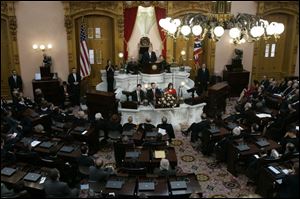
Gov. Ted Strickland addresses members of the General Assembly in the Ohio House chamber.
Not when Ohio governors like baseball managers pumping up their fans with great expectations during spring training seem more intent on balancing flowery rhetoric with nuts-and-bolts details about their spending plans, while tempering their bold resolve with empathy for the downtrodden.
To some extent, people accept probably even crave a little embellishment.
They want governors who are hopeful but not distressed about the future, Ohio Senate Majority Floor Leader Randy Gardner said.
I think political leaders believe people respond better to words of hope than words of dismay, Mr. Gardner (R., Bowling Green) said. It s fairly logical.
Feel-good phrases
Another ingredient of State-of-the-State addresses are the occasional warm and fuzzy phrases to help Ohioans feel good about their place in history.
Mr. Celeste ended his first State of the State in 1983 by saying how brave men and women carved Ohio out of the wilderness some 180 years earlier.
Although they lacked a shared past, they were knit together by the dream of a shared future, he said.
Similarly, Mr. Strickland called Ohioans resilient, ready to reject the status quo, and ready to embrace transformational changes that will bring even better days ahead.
The governor went on to pitch his plan for a massive $1 billion investment in energy research and development by calling the Buckeye State the heart of our nation and the heart of innovation that must be open to new ways of doing things and new ways of thinking.
The strategies and ideologies of the 20th century will not make us strong in the 21st century, he said.
Looking forward
Mr. Strickland veered from the norm himself by making energy a focal point of his State of the State and by bringing it up right after the opening pleasantries.
Next-generation energies, as he called them biofuels, fuel cells, clean coal, and renewable sources such as wind and solar will get a tax-exempt bond cap allocation of $250 million a year if he gets his way.
The goal is to leverage billions of more dollars for investment in energy projects to create jobs, support our farmers, reduce our dependence on foreign oil producers, and be responsible stewards of our environment, Mr. Strickland said.
The governor was barely finished speaking before Jack Shaner, Ohio Environmental Council spokesman, fired off a press release saying how the group one of Ohio s largest nonprofits was pleased and ready to work with him to make his energy goals a reality.
Mr. Gardner has been in the Ohio General Assembly for 22 years. He said he has never seen a State of the State kept under wraps as tightly as Mr. Strickland s. Consequently, there were more legislators taking notes than usual and less prespeech buzz, he said.
But there were also more questions. Some of the ideas were big, some were new, and some were potentially controversial, Mr. Gardner said. If their goal was to keep information from the public until the speech, they did a good job.
A matter of style
The oratory style of Ohio s four most recent governors has differed too.
Even Republicans such as Mr. Gardner and Mr. Batchelder believe the two Democrats, Mr. Strickland and Mr. Celeste, had more charisma and flair behind the podium, almost rousing their audiences as if they were leading pep rallies.
Mr. Batchelder called Mr. Celeste Kennedyesque.
Mr. Gardner said he was pleasantly surprised by Mr. Strickland s forward-looking approach. He kind of said, This is a new day and here we go, he said.
Mr. Voinovich impressed them as a details-oriented professional, yet one who came off as stiff as a chief executive officer talking to his shareholders or board of directors.
He was pretty mechanical as a speaker. He was not an orator, Mr. Batchelder said. I wouldn t bring him to a pep rally, let s put it that way.
He said Mr. Taft was never comfortable in his own skin.
Contact Tom Henry at:thenry@theblade.comor 419-724-6079.